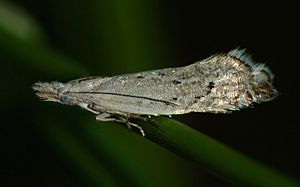Cocksfoot stem borer facts for kids
Quick facts for kids Cocksfoot stem borer |
|
|---|---|
 |
|
| Scientific classification | |
| Synonyms | |
|
Glyphipterix achlyoessa, also known as the cocksfoot stem borer, is a small moth. It belongs to the Glyphipterigidae family. This moth is special because it is only found in New Zealand.
Contents
About the Cocksfoot Stem Borer
Who Discovered This Moth?
This moth was first described in 1880 by Edward Meyrick. He named it Phryganostola achlyoessa. Meyrick found the moth in January at the Wellington Botanic Garden. He saw it flying around at dusk. Later, in 1928, George Hudson wrote about and showed pictures of this moth. He used the name Glyphipterix achlyoessa.
Where is the Original Specimen?
The very first specimen of this moth, called the holotype, is kept in a museum. You can find it at the Natural History Museum, London.
What Does This Moth Look Like?
The cocksfoot stem borer is mostly whitish-grey. It has some darker markings that look like faint stripes. You might also see a few black scales on its wings. Its legs are a pale, yellowish-grey color. The hind wings are a smoky-grey.
Where Does This Moth Live?
This moth is endemic to New Zealand. This means it is only found there and nowhere else in the world. It is quite common and can be seen all over the country.
Life and Habits of the Moth
When Does the Moth Fly?
You can usually see these moths flying from October to December. This is when they are most active.
What Does It Do When Disturbed?
If something disturbs this moth, it will fly away quickly. But it usually only flies a short distance. Then it lands on a grass stem to hide.
Where the Moth Lives and What It Eats
Preferred Home for the Moth
This moth likes to live in open, grassy areas. You can often find it in meadows. It seems to prefer types of grass that have been brought to New Zealand from other places.
What Plants Do the Larvae Eat?
The young moths, called larvae, eat certain plants. One of their favorite foods is a grass called Dactylis glomerata, also known as cocksfoot. The larvae also bore into plants from the Juncus group.
Images for kids




